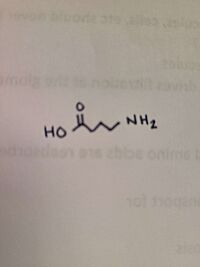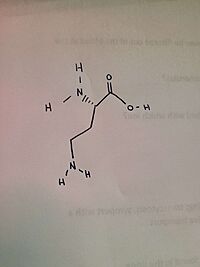Sandbox Reserved 1761
From Proteopedia
(Difference between revisions)
(New page: {{Sandbox_Reserved_BHall_F22}}<!-- PLEASE ADD YOUR CONTENT BELOW HERE --> ==Your Heading Here (maybe something like 'Structure')== <StructureSection load='1stp' size='340' side='right' cap...) |
|||
| (31 intermediate revisions not shown.) | |||
| Line 1: | Line 1: | ||
{{Sandbox_Reserved_BHall_F22}}<!-- PLEASE ADD YOUR CONTENT BELOW HERE --> | {{Sandbox_Reserved_BHall_F22}}<!-- PLEASE ADD YOUR CONTENT BELOW HERE --> | ||
| - | == | + | ==Human ornithine aminotransferase (''h''OAT)== |
| - | <StructureSection load=' | + | <StructureSection load='7T9Z' size='340' side='right' caption='Caption for this structure' scene=''> |
This is a default text for your page ''''''. Click above on '''edit this page''' to modify. Be careful with the < and > signs. | This is a default text for your page ''''''. Click above on '''edit this page''' to modify. Be careful with the < and > signs. | ||
You may include any references to papers as in: the use of JSmol in Proteopedia <ref>DOI 10.1002/ijch.201300024</ref> or to the article describing Jmol <ref>PMID:21638687</ref> to the rescue. | You may include any references to papers as in: the use of JSmol in Proteopedia <ref>DOI 10.1002/ijch.201300024</ref> or to the article describing Jmol <ref>PMID:21638687</ref> to the rescue. | ||
| + | [[Image:Gaba.jpg|200 px|thumb|left|GABA]] | ||
| + | == Function of your protein == | ||
| + | The specific function of <scene name='93/934005/Spin/2'>Human ornithine aminotransferase</scene> (''h''OAT) is that of an enzyme. It can be found in humans, as well as mice and pigs. It helps transfer L-ornithine’s δ-amino group to α-ketoglutarate (α-KG). <ref>https://doi.org/10.1016/j.jbc.2022.101969</ref> There is a lack of understanding in regards to ''h''OAT's catalytic mechanism, even though it is a key component of human metabolism. As noted in the article, ''h''OAT operates on a "Bi-Bi, Ping-Pong" kinetic mechanism resulting in the first part of the reaction undergoing a conversion of PLP -> PMP and L-Orn -> L-GSA. Then PMP's amino group is catalyzed by ''h''OAT creating an α-KG. | ||
| + | [[Image:Daba.jpg|200 px|thumb|right|DABA]] | ||
| + | The binding affinities of GABA and AVA were higher and resulted in slower turnovers. This raised the question that AVA and GABA would be good drug targets, rather than specifically ''h''OAT. | ||
| - | == | + | == Biological relevance and broader implications == |
| + | ''h''OAT is important because it is heavily involved in the urea cycle. In mammals, it dictates a large portion of the development of neonates. The research on this protein is relevant to science as a whole because it could directly impact cancer research and lead to the creation of cancer management in humans. There has been overexpression of ''h''OAT within Hepatocellular carcinoma (HCC) cells, therefore there is reason to believe that the overexpression of ''h''OAT is an indication of chronic liver diseases and cancer of the liver. The inhibitors include: y-aminobutyric acid (GABA), 5-aminovaleric acid (AVA), and L-2,4-diaminobutyric acid (DABA). The highest affinity of binding with ''h''OAT is GABA. It also has a higher percentage of return in the reverse reaction. The more that ''h''OAT is understood and researched, the more inactivators can be designed to combat the overexpression of ''h''OAT that is found in conjunction to HCC. | ||
| - | == | + | == Important amino acids== |
| - | + | The ligand of ''h''OAT is Pyridoxal-5'-Phosphate <scene name='93/934005/Plp/1'>(PLP)</scene>. The role of the catalytic amino acids in an enzyme is to bind to a substrate, changing the structure, causing bonds to break and new bonds to be formed. When there is a difficult reaction, the triad of amino acids works in tandem to facilitate the reaction. A <scene name='93/934005/Glu235/1'>Glu 235</scene>-<scene name='93/934005/Arg413/1'>Arg 413</scene> <scene name='93/934005/Arg_413_glu_235/1'>salt bridge</scene> was found on AVA, but not on GABA. In regards to GABA, the salt bridge was disrupted in 30% of the monomers. | |
| - | == | + | The crystal soaking experiments created an opportunity to decipher the reaction intermediates of the structures. While GABA linked to PLP covalently, PLP and catalytic <scene name='93/934005/Lys_292/1'>Lys 292</scene> were linked by AVA. |
== Structural highlights == | == Structural highlights == | ||
| - | + | <scene name='93/934005/Main_secondary_features/1'>Main Secondary Features</scene> | |
| + | |||
| + | <scene name='93/934005/Tert/1'>Tertiary/Quaternary Features</scene> | ||
| + | <scene name='93/934005/Space_fill_plp/1'>Space filling view of PLP</scene> | ||
| + | <scene name='93/934005/Space_fill/1'>Space filling view of ''h''OAT</scene> is relevant because it shows the space that the atoms of the structure take up. | ||
| + | 5-aminovaleric acid (AVA) lacking α-amino group does not impact the initial binding of the substrate and enzyme. | ||
| + | </StructureSection> | ||
| + | |||
| - | </StructureSection> | ||
== References == | == References == | ||
<references/> | <references/> | ||
| + | Butrin, A., Butrin, A., Wawrzak, Z., Moran, G. R., & Liu, D. (2022). Determination of the ph dependence, substrate specificity, and turnovers of alternative substrates for human ornithine aminotransferase. Journal of Biological Chemistry, 298(6), 101969. https://doi.org/10.1016/j.jbc.2022.101969 | ||
Current revision
| This Sandbox is Reserved from November 4, 2022 through January 1, 2023 for use in the course CHEM 351 Biochemistry taught by Bonnie Hall at the Grand View University, Des Moines, USA. This reservation includes Sandbox Reserved 1755 through Sandbox Reserved 1764. |
To get started:
More help: Help:Editing |
Human ornithine aminotransferase (hOAT)
| |||||||||||
References
- ↑ Hanson, R. M., Prilusky, J., Renjian, Z., Nakane, T. and Sussman, J. L. (2013), JSmol and the Next-Generation Web-Based Representation of 3D Molecular Structure as Applied to Proteopedia. Isr. J. Chem., 53:207-216. doi:http://dx.doi.org/10.1002/ijch.201300024
- ↑ Herraez A. Biomolecules in the computer: Jmol to the rescue. Biochem Mol Biol Educ. 2006 Jul;34(4):255-61. doi: 10.1002/bmb.2006.494034042644. PMID:21638687 doi:10.1002/bmb.2006.494034042644
- ↑ https://doi.org/10.1016/j.jbc.2022.101969
Butrin, A., Butrin, A., Wawrzak, Z., Moran, G. R., & Liu, D. (2022). Determination of the ph dependence, substrate specificity, and turnovers of alternative substrates for human ornithine aminotransferase. Journal of Biological Chemistry, 298(6), 101969. https://doi.org/10.1016/j.jbc.2022.101969


